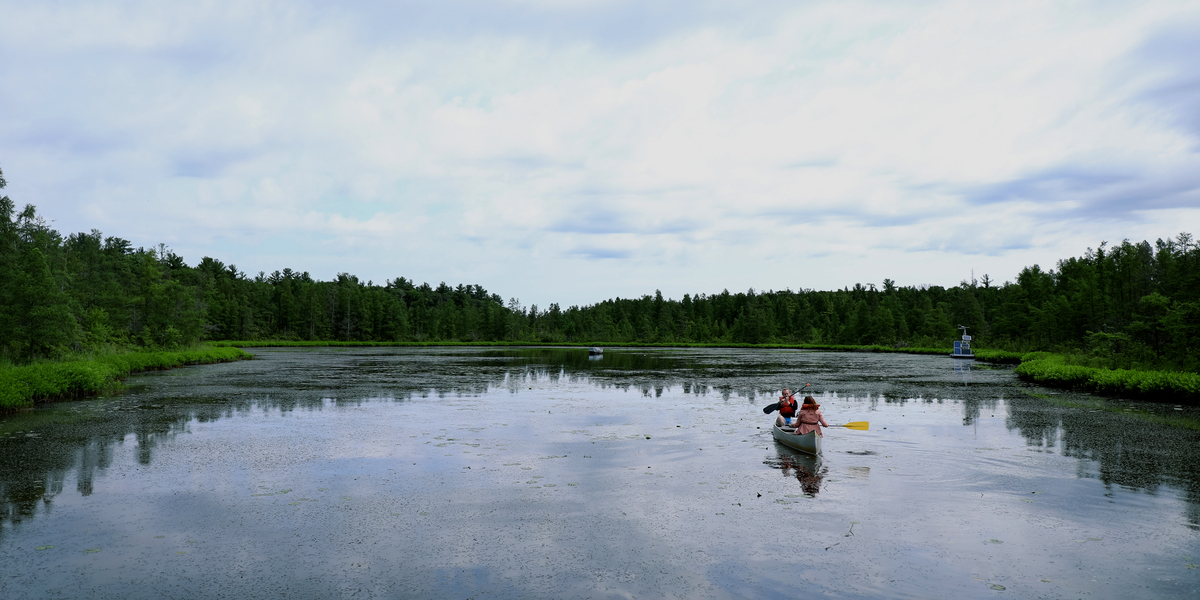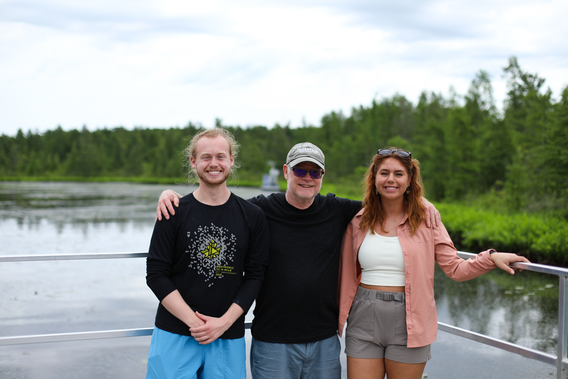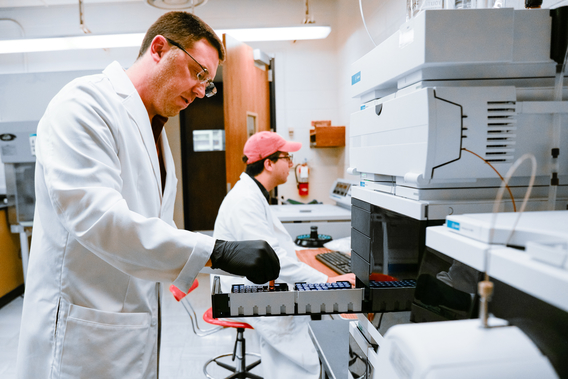
Vanessa Czeszynski and Reid Brown, graduate students in Jim Cotner's lab, paddle to the monitoring station in the middle of Cedar Bog Lake at Cedar Creek Ecosystem Science Reserve to measure carbon dioxide and methane cycling.
Ever accidentally gulp lakewater during an afternoon swim? You may want to spit that out, especially after you hear the list of pollutants that have been found in countless lakes in Minnesota and across the country. Though the concentrations are often very low, anticonvulsants, birth control, insect repellant, heavy metals, “forever” chemicals, even oxycodone – basically anything you flush down the toilet, dump in the trash or spray on your lawn will find its way into local water sources. Small amounts may even be in drinking water.
“In remote lakes and especially in and downstream of urban and agricultural areas, there are often concentrated inputs of pollutants into watersheds,” says Jacques Finlay, a freshwater ecologist in the College of Biological Sciences (CBS) Department of Ecology, Evolution and Behavior. Some contamination is acute but transitory. For example, on the fourth of July in 2019 over 200 people became sick after swimming in Lake Minnetonka, most likely from human waste. Other pollutants stick around much longer. Industrial pollutants can leach from soil and waste sites long after they’ve entered the environment.
“It’s not all gloom and doom. But now we have to deal with it,” says Claudia Schmidt-Dannert, the director of the Biotechnology Institute (BTI) and a professor of Biochemistry, Molecular Biology and Biophysics. While Finlay works with a group of scientists identifying the environmental and sociopolitical challenges of current urban water management strategies, a number of researchers in BTI are exploring the use of emerging biotechnologies to address the most pervasive of water toxins. “We have to do this, for some chemicals especially,” says Schmidt Dannert. “We won’t find anything in nature that can degrade [these toxins].” In short, some human-caused problems may require human-designed solutions.
A fluid footprint: tracing toxins back to the source
Once a toxin enters an aquatic environment, it can be difficult to identify where it’s from because everything in a watershed is connected. Rainwater rushes over soil into storm drains and local water bodies (lakes, ponds, rivers, streams) – bringing with it fertilizer, road salt, heavy metals and plastic. From there, pollutants either get bound in sediment and vegetation or they slowly seep into the aquifers we drink from.
Pollution on land tends to correspond with contamination in local water bodies.“If you're in a watershed that has high soil and runoff lead concentrations for example, there's a good chance that human blood levels of lead are elevated there, too,” says Finlay.

An extreme example is in the east metro of the Twin Cities, where two plumes of “forever chemicals” – a durable group of chemicals commonly used in non-stick pans, rain-coats, and fire-retardants – are slowly spreading from old 3M waste sites and contaminating private wells with concentrations far exceeding federal standards. The concern is extreme enough that the city of Woodbury plans to drill dozens of additional wells to remove as much contaminated water as possible from local aquifers, treat it and then pump the clean water back into the ground.
Aquatic ecosystems near agricultural landscapes are also susceptible to nutrient overload from fertilizers and organic matter. Excess nutrients can cause toxic algae blooms or “eutrophication” which effectively reduces the levels of oxygen within the water. Not only does this affect aquatic life like fish, it can also shift the way microorganisms in the lake metabolize greenhouse gasses like methane, carbon dioxide and nitrous oxide. Lakes have the potential to store and release the gasses that play a pivotal role in climate change – scientists like Jim Cotner would definitely prefer the former.
“Eutrophication plays a huge role in an increase of methane production,” says Cotner, a professor of Ecology, Evolution and Behavior whose expertise involves characterizing the role of microbial life in lake nutrient cycling.

Other more direct inputs of pollution can be from animal waste (dogs, probably) or humans (either from littering at the beach or because they don’t have another place to “go” while out ice-fishing). But the final destination for water used at home is the sewage system. In the Twin Cities, most sewage funnels to the Metropolitan Wastewater Treatment Plant in St. Paul, which discharges treated water right back into the Mississippi.
One might think that the water coming out of a wastewater treatment site would be pristine. Depending on local infrastructure and regulations – the water is much cleaner and safer than if it’d come straight from the sewer, which makes sense as it has to meet certain federal regulations. But aquatic habitats downstream of wastewater treatment centers often suffer from chronic exposure to chemicals.
“While wastewater treatment plants work well for some things better than ever before, there are many chemicals that aren't treated effectively by current designs. We lack a good understanding of these effects,” says Finlay. “But there are a growing number of studies that show that downstream of wastewater treatment plants, there are a lot of problems that arise in ecosystems from this kind of ‘soup’ of chemicals in water that’s not effectively treated.” This includes pharmaceuticals. When as a part of a seven-year study, a group of Canadian scientists pumped an extremely low concentration of a synthetic estrogen into a lake, the drug caused an entire fish population to almost completely collapse.
Estrogen isn’t even the most frequently observed drug found in water. A reputed global study found that carbamazepine (a drug used to treat seizures), metformin (a Diabetes drug) and caffeine are among the top most detected drugs among local water sources. Not all wastewater treatment systems are equally effective at filtering them out. However, wastewater treatment centers that are effective at filtering pharmaceuticals may provide valuable insight for those looking to improve infrastructure. It also opens a wide window of opportunities for research.
Nature’s natural buffers
Tom Niehaus, a professor in the College’s Department of Plant and Microbial Biology, is in the process of characterizing several species of bacteria that can degrade metformin.“The first documentation of a bacteria that can metabolize metformin was from a bacteria found at the wastewater treatment plant in Saint Paul,” says Niehaus. He initially coordinated with Larry Wackett – a McKnight professor in the Department of Biochemistry, Molecular Biology and Biophysics – to fund Katie Wissbroecker, a graduate student who spear-headed the project. “Katie actually went there and collected the activated sludge that we were able to isolate these bacteria from.” Collectively, Niehaus and Wackett have identified at least six metformin-degrading bacteria in their research, though Wackett’s team was the first to identify the gene encoding the drug-degradation enzyme.
What Niehaus finds especially intriguing is that after their discovery, people have started documenting metformin-degrading bacteria all over the world. The drug-degradation gene seems to have jumped from a bacteria’s genome to bacterial “plasmids,” circular pieces of DNA bacteria can pass on to other bacteria (even bacteria of another species).

“The trait essentially went viral,” says Niehaus. “It’s impressive how quickly bacteria can adapt to these environments. It really shows how they act sort of like nature’s natural buffer.” Because bacteria are relatively simple to study, manipulable and evolve relatively quickly (even in nature), they may play an important role in all future water remediation projects.
Upping the bacterial ante
To Wackett, however, the only thing better than a natural buffer is a super-natural buffer. Some naturally-occurring bacteria already possess traits that help them break down plastic, bind to metals, or survive in toxic environments. But scientists like Wackett are experts at engineering (genetically “tweaking”) bacteria to become even more efficient at specific jobs – like breaking down pollutants. And that’s exactly what Wackett is interested in doing. His research interests revolve around engineering bacteria so they can effectively break down the most stubborn of toxins, including the “forever chemicals” polluting the east metro of the Twin Cities.
Forever chemicals – also known as per- and polyfluoroalkyl substances (PFAS) – are so named because they don’t degrade in nature and are among the most challenging of toxins to remove from water. They’re so indestructible that before they were used for non-stick cooking pans, rain-coats and heart valve replacements, they were used to resist corrosion from reactive chemicals in World War II explosives. By the time several forever chemicals were publicly linked to cancer and developmental health issues, they were already ubiquitous in our drinking water. Unless we remove them ourselves, they’ll persist in nature for up to 10,000 years from now.
“Bacteria haven’t evolved the processes to break down forever chemicals,” says Wackett. Most modern methods used to eliminate forever chemicals from the environment involve completely removing a contaminated source (i.e. valuable drinking water or layers upon layers of topsoil) and either storing it indefinitely or degrading it at an extremely high heat. “But we do know of an enzyme that can break down smaller fluorinated molecules than the ones found in forever chemicals – if forever chemicals can be broken down they don’t present as much of a concern.”
Wackett’s team is engineering a Pseudomonas putida bacterium (in his words, “speeding up evolution”) so it can break down the longer fluorinated chains found in forever chemicals. So far his research has had mixed success – the current rendition of the bioengineered bacteria can break down the long fluorinated chains, but the bacterium suffers stress from the fluoride released while doing so. They are now engineering bacteria to become more resistant to fluoride, making them effective PFAS degraders.
Two is better than one
Schmidt-Dannert ups the ante even further by engineering two or more bacteria species to depend on one another, forming a robust, surface-adhering layer of bacteria called a “biofilm” that can be grown on silica mats for industry use. (An example of a biofilm that exists in nature is dental plaque. Another is tile slime and the squishy blob in some kombucha bottles).

She’s working with Wackett to integrate P. putida into a biofilm filtration system that can scrub forever chemicals from water – and she also recently received a grant to explore the use of biofilms in “mining” metals from mining wastewater. “It’s not that we are reinventing nature,” says Schmidt-Dannert. “We’re just moving it along a little bit to help bacteria become resistant and efficient.”
Their approach lends itself well to a problem that requires intervention as well as prevention. While it would be ideal to eliminate or reduce pollution entirely, even some sustainable technologies (like electric vehicles) have to account for things like lithium batteries – a material which can only be sourced from mines. Pharmaceuticals are also life-saving to those who need them. A solution that addresses more sustainable practices while also reducing the impacts of toxins on local communities may be an optimal way forward.
Ultimately, solving this generation’s water-pollution crisis will require multiple approaches.
“There’s no fix-all solution yet that’s going to treat everything we want to in wastewater,” says Finlay. “I mean, we’ve built an urban environment that’s designed to drain water away really quickly.” He notes that public awareness and education may be a big part of reducing pollution inputs, like getting people to dispose of medication in a safe way or picking up after their dogs. Another option would be to direct stormwater run-off into sewage systems instead of into surface water like the Mississippi River. Of course, that would still mean incorporating better water treatment technologies.
“I’d love to be able to drink water without worry,” says Schmidt-Dannert. She feels as though implementing team-work and demystifying genetically engineered organisms could bring some big breakthroughs. “I think we can make it happen.” — Adara Taylor